Email campaigns are one of the most effective methods of communicating with your audience. If someone’s subscribed to your list, chances are they’re interested in what you have to offer. You have their interest – now you need to grab their attention.
The simplest way to do this is through a plain old follow-up email. It’s direct, and also offers a nice personal touch. In this article, we’ll talk about why you should send follow-up emails, some rules for sending them, then dive into how to create them in five steps. Let’s get started!
Why You Should Send Follow-Up Emails
For the uninitiated, follow-up emails do exactly what they say on the tin: they’re used as additional outreach after an initial contact is made. For example, follow-up emails are ideal when it comes to job interviews and networking opportunities. Here, they provide you with an opportunity to distinguish yourself from the pack, or re-open the lines of communication.
When it comes to email campaigns, your objective is a bit more complicated (although similar). For a start, you get a second chance to convince subscribers to engage with you (potentially increasing conversions). Furthermore, a lot of users tend to perceive email campaigns as nothing more than a sales attempt. Sending a follow-up email can be enough to set you apart in quite a few cases – doubly so if you create a killer one.
3 Basic Rules for Follow-Up Emails
While the concept of a follow-up email is easy to grasp, there are a few ground rules you need to know if you want yours to be successful. Here are three basic rules to follow.
1. Follow Up at the Right Time
The first rule to a successful follow-up email is to get your timing right. Wait too long after the initial contact, and you run the risk of subscribers forgetting who you are. If you’re too quick off the mark, you may come across as too pushy.
If you fail to get the timing right in either direction, you jeopardize your chances of increasing engagement – rendering your follow-up email a flop. As a rule of thumb, we recommend waiting around a week before sending a campaign follow-up email, unless you’re contacting someone who’s just signed up to your list. In that case, you want to follow up their subscription notification as soon as possible.
A simple split test can help you determine the perfect follow-up window for your audience. Try to segment your subscribers into different groups, then test their responses to the same follow-up email sent at different times. Use a week as your baseline, and work your way down as necessary until you find the sweet spot. Your mileage may vary if you increase the time, since you’ll run the risk of users forgetting your initial message.
2. Use the Right Tone
Aside from bad timing, nothing can wreck a follow-up email faster than not using the right tone. Sounding too pushy will do nothing but reinforce the notion that you’re trying to sell something. On the other hand, being too apologetic may cause you to lose your subscriber’s interest before you get the chance to make your case.
There’s not a single tone that will satisfy all your subscribers, but keeping things friendly is always a good bet. Sounding authoritative instead of apologetic also increases your chances of being taken seriously. If you don’t come off as knowledgeable, your subscribers will wonder why they should be paying attention to your advice in the first place.
Let’s check out an example of a follow-up email written authoritatively:
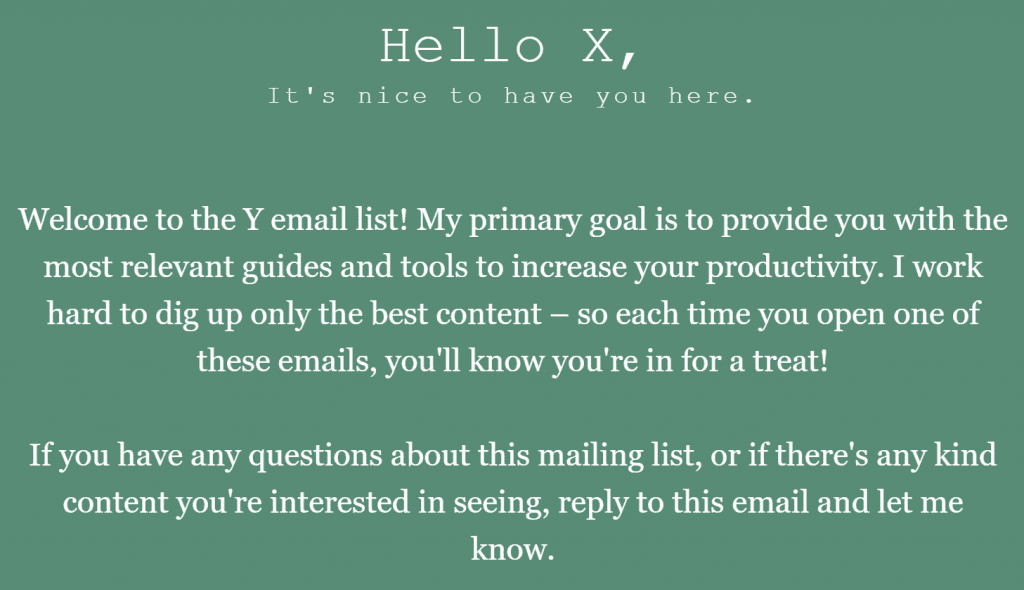
This message is a friendly follow-up email to a subscriber who has just joined our list. We made an authoritative appeal highlighting the benefits the product would bring them. As long as you are providing your subscribers with the most relevant content and tools for their needs, there’s no need to be shy about it.
3. Give Your Subscribers an ‘Out’
While sending the occasional follow-up email is all well and good, sending a barrage of them is a faux pas. At some point, no amount of follow-up emails are going to help you convert certain subscribers. For these, you need to accept it, move on, and focus your efforts on polishing your campaigns even further.
The best way to deal with this issue is to provide subscribers with an easy out – a simple way to get off your mailing list. Most major email campaign managers include this option by default in their messages:

When writing a follow-up email, we consider it good practice to be more explicit about this option. That way, we prove to our subscribers we’re not looking to inconvenience them, but just the opposite. Let’s use an example to illustrate this rule:
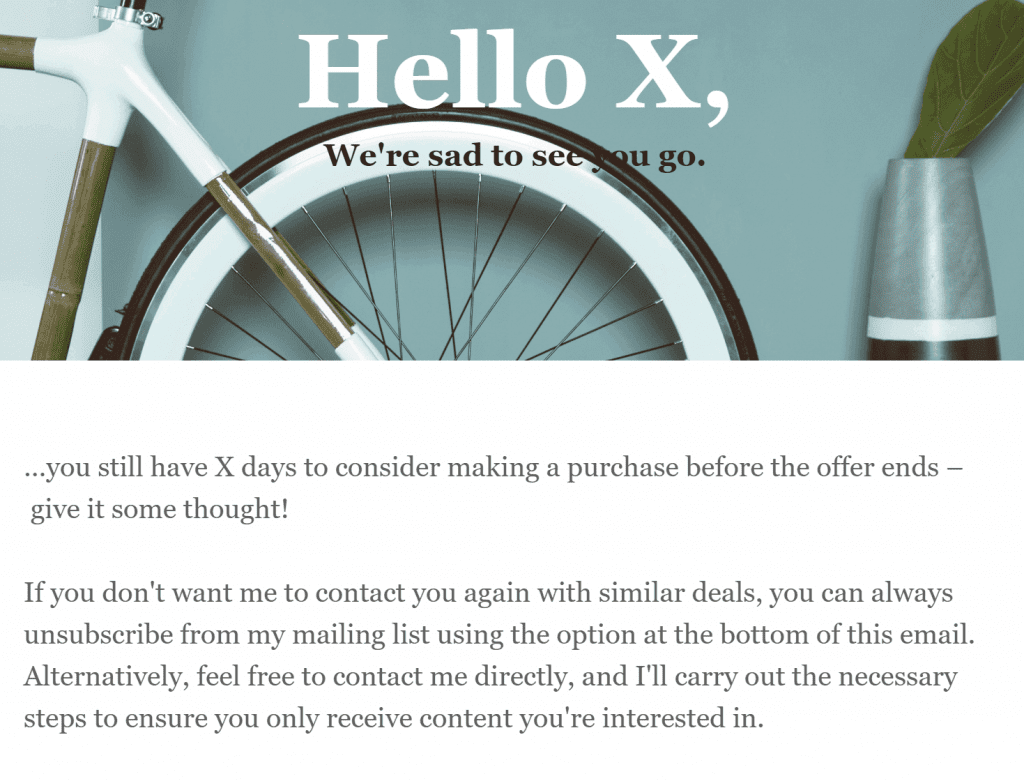
Notice how we mention both the classic unsubscribe option, and an alternative that other users might find more palatable? It gives the reader multiple options, further enhancing our customer-first stance.
As we mentioned earlier, you can segment your subscriber’s list into several categories. Doing so enables you to create unique lists where users can opt out of any deals you might send their way. That way, you get to retain them on your mailing list and contact them down the road to re-establish a connection if necessary.
5 Steps to Create Engaging Follow-Up Emails
Now that we’ve covered the ground rules of follow-up emails, it’s time to check out the five steps to creating one. Let’s start with setting a goal.
1. Set a Clear Goal
To begin with, each follow-up email should be written with a clear goal in mind. Maybe you’re chasing a conversion, or just welcoming a new member to your mailing list. Either way, you need to have a clear goal before writing.
That being said, not setting a clear goal doesn’t necessarily mean your follow-up email is going to be a failure. However, it makes tracking your success practically impossible, and prevents you from carrying out any advanced tests (more on this later). Goals will – of course – vary depending on the specifics of your campaigns, but here are a few basic examples to provide you with some guidance:
- A potential customer abandons a shopping cart with several items on your e-commerce site. You send them a follow-up email with the explicit intention of getting them to complete their purchase.
- You send out an email campaign promoting a product or a service, but conversions are lower than expected. In this case, your follow-up email seeks to increase them by informing subscribers about the benefits your company offers.
- You’ve gained a new subscriber, and you want to promote your services.
In each of those scenarios, having a clear goal in mind enables us to track our success over time. From here, we can use that data to refine our future attempts. For example, if you want to check whether customers complete a purchase after receiving your follow-up email, you can set up goal tracking as part of MailChimp. On the other hand, if you’re sending a follow-up email to a new subscriber, you can simply check the open and click rates to find out if they’re engaging enough.
2. Write a Compelling Subject Line
Once you have a goal in mind, it’s time to put your fingers to your keyboard and write a compelling subject line. This sets the tone for the rest of your follow-up email, and it matters a lot as far as opening rates go.
For example, going with a generic subject line could give subscribers the impression your mailing list has nothing of value to offer, or worse, make them write you off as sales spam. With that in mind, avoid unimaginative titles such as “Click for a Great Deal!” or “Huge Discount, Only Today!”. In fact, as far as follow-up emails go, your titles should be a bit more personal since your goal is to reinforce the ties between you and your subscribers. To get on the right wavelength, think less about marketing campaigns, and more about writing to a friend or acquaintance, such as:
- “Hello X, I’m writing about Y”.
- “X, I hope to help you with Y”.
- “X ways I can assist you with Y”.
That last line is one of our favorites for follow-up emails to new subscribers. It’s short, and shows your primary goal is to provide value to your subscribers. Make sure yours are concise, and either explain what you can offer, or create a sense of urgency (by talking about due dates, for example).
As with follow-ups, you can use split testing to great effect when it comes to subject lines. Once your subscriber list is large enough for your results to be statistically significant, you can try out different headlines to see which ones get more users to open your follow-up emails.
3. Provide Context
A good follow-up email always provides enough context for your readers to connect the dots about how they began the relationship. It doesn’t matter whether it’s a personal follow-up, or a “Hello” to a new subscriber – providing context is always good practice.
Failing to do so could result in some of your subscribers not remembering how they came to be part of your list. It’s not a good idea, especially considering how simple it is to implement. We recommend kicking off your follow-up email with the context itself, so you have a natural segue into the rest of your message. For example:
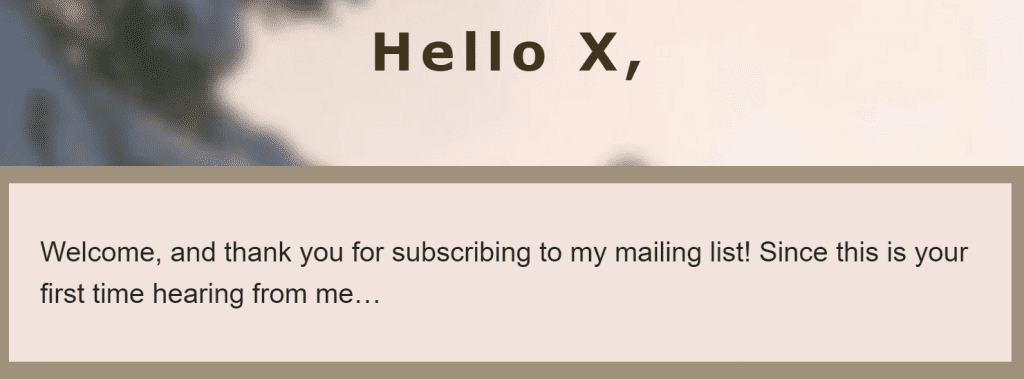
Keep the rest of you context short and to the point. You don’t need to recap every step of your relationship, just enough to jog your subscriber’s memory. The context of your follow-up email depends on your relationship with your subscribers – so go with your gut for this one.
4. State Your Intentions
Now you’ve provided context, it’s time to state the purpose of your follow-up email. As we’ve mentioned earlier, not all follow-up emails are made equal. It means you have to tell subscribers why you’re writing to them.
Being upfront about your intentions saves everyone time, and it enables subscribers to determine right away whether your content is something they care about. To illustrate this point, let’s build on the same example we used during step three:
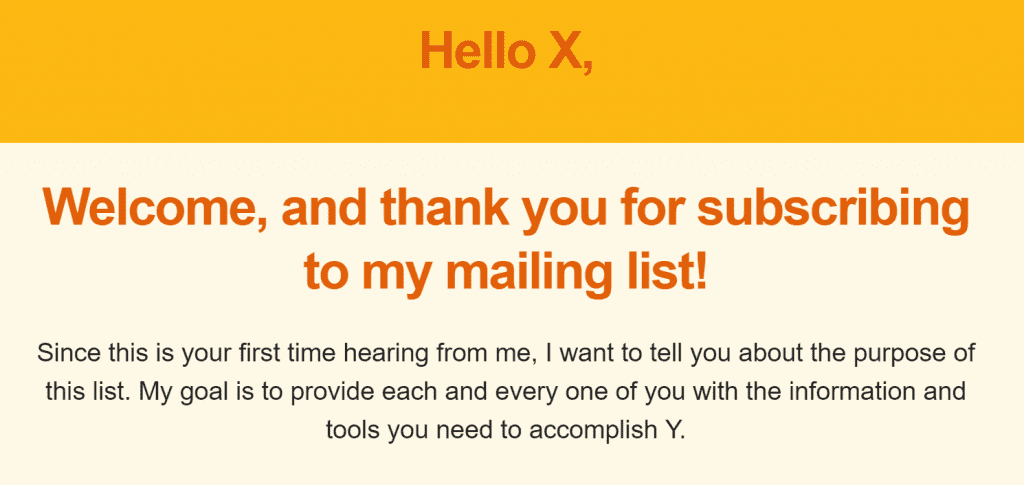
Here, we go straight from the context to our intentions. There’s no reason to mince words, since subscribers should already have an idea of what they’re in for (thanks to your compelling subject line). As with context, your intentions will vary depending on the purpose of your follow-up email, so remember always to be upfront (yet still friendly!).
5. Compose a Solid Message
We’ve covered almost every step to creating a follow-up email – all that’s left to do is write the body of our message.
When it comes to follow-up emails, a lot of the time your message will be near complete by the time you get to stating your intentions. Remember: they’re tools meant to increase engagement, and perhaps even lead to conversions. As a result, they don’t need to be overly long to accomplish their purpose – consider them a digital version of ‘touching base’.
However, for follow-up emails to new subscribers, we can expand upon our message by providing some additional value. For example, you could offer access to a downloadable guide to cement yourself as an authority on a subject they care about:
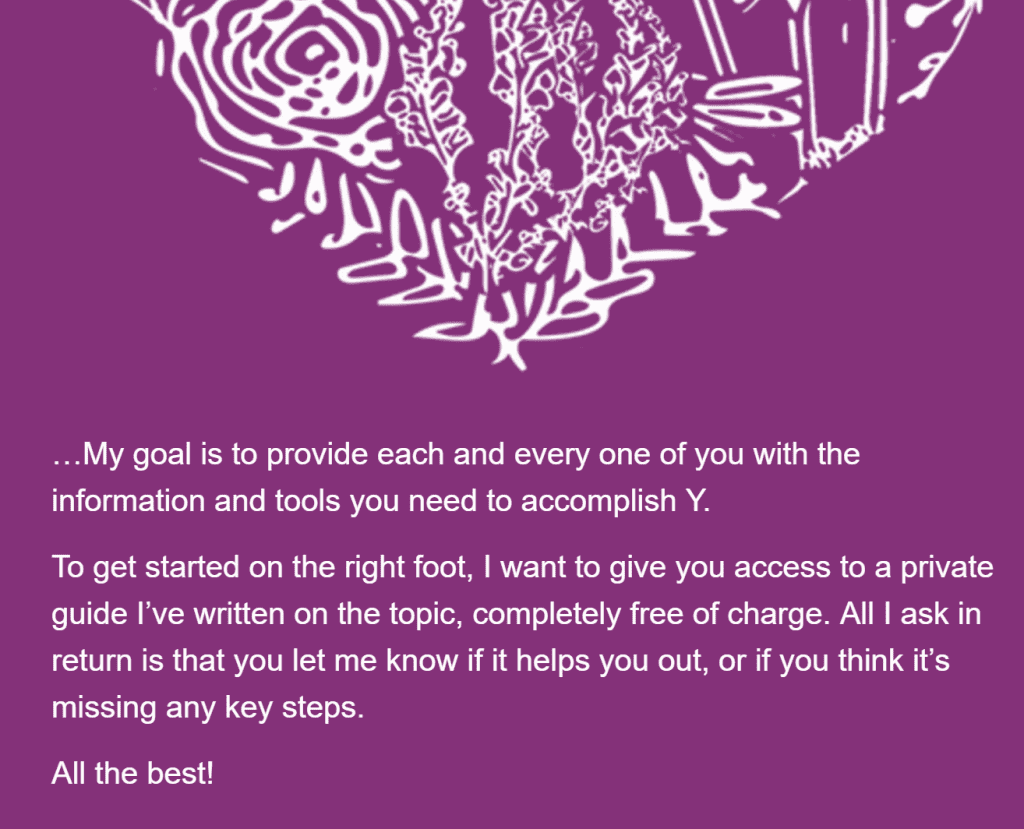
You don’t necessarily need to go down this route when it comes to your own follow-up emails, but it should follow the same principle. After stating your purpose, offer something to your reader that they will find relevant. It will help cement you as someone who wants to help your subscribers, and could pay off in dividends thanks to the principle of reciprocity.
Conclusion
Getting email subscribers to engage is one of the most difficult tasks we all face, but it’s not impossible. Follow-up emails are simple in principle, but require some effort to get right.
By following the steps outlined in this piece, a simple follow-up email could make all the difference to your subscriber rate and conversions:
- Define your goal.
- Kick things off with a compelling subject line.
- Provide context to jog your subscriber’s memory.
- State your intentions.
- Create a solid message.
Do you have any secrets for creating a compelling follow-up email? Subscribe and share your thoughts with us in the comments section below!
Article thumbnail image by vladwel / shutterstock.com.









Thanks John for all these amazing tips. However, I wanna know how many follow up emails do you suggest before considering to cross out that prospect from the list?
That is absolutely your decision, Emmerey. Different businesses have various strategies – a post such as this (https://blog.woodpecker.co/cold-email/follow-up-emails-how-many-how-often/) may help you. 🙂
I usually keep m follow up emails straight forward like i ask them or tell them what i really wanna ask/tell. Many of times i get no response. What should i do to fix this?
Thanks in advance. 🙂
Test and measure Tom; that is the key to most things 😉
Comprehensive and useful guys, as always. Thank you.
Follow-up emails are indeed super important in many online niches.
Great how-to and ideas!
My only addition would be to go with the left-justified text in the last example rather than the center-aligned text in the first example. The latter is very hard to read. Centered text generally works better for titles or headlines than body copy, IMO.
Thanks for all the great tips and techniques!
Good suggestion Caryn, thanks!